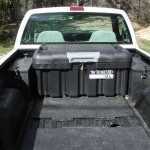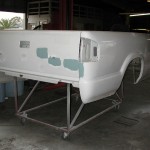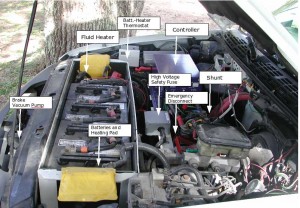Electric energy has a lot of advantages. It is easy to store, easy to convert, it is safe, easy to transport and easy to produce. It powers our modern way of life, but it can do a lot more.
It is also a form of energy that can be produced locally, with wind- or water turbines, ground heat or bio gas driven turbines, solar panels or through power-heat coupling.
Electric vehicles would be a logical extension to our electrified life. This is why I built my very own electric truck. Though I sold it a few years ago, it was a cool car and I learned a lot.
Safti (Saft .. the German tranlastion of ‘juice’):
 Safti started it’s life as an ordinary Chevy S-10 longbed truck. But it only collected about 7,000 Miles on its ICE and a convertion was started. Unfortunately, the original builder soon passed away and Safti was stored in a barn for a few years. Others tried to continue the conversion but, well, it didn’t work out. So, finally Safti ended up in Texas.
Safti started it’s life as an ordinary Chevy S-10 longbed truck. But it only collected about 7,000 Miles on its ICE and a convertion was started. Unfortunately, the original builder soon passed away and Safti was stored in a barn for a few years. Others tried to continue the conversion but, well, it didn’t work out. So, finally Safti ended up in Texas.
When it arrived here, it had bad tires, its batteries were shot, the 12V system not functioning and other parts missing or broken. Somebody had, well, more or less ‘nailed’ a speedometer on Safti’s dashboard breaking and cracking it in the process.
Over the last few months, Safti got new tires, new batteries, the 12V system was repaired bypassing the missing onboard computer, the ‘on-dash’ speedometer was removed and the original speedo was rewired using a ‘Dakota Digital’ signal coverter. A battery heater system was installed using NAPA heating blankets and a cheap ‘WalMat’ type a/c thermostat. While the batteries were kept warm, the driver was not. So, a MES-DEA fluid heater was hooked up to the (now repaired) climate system and, viola, warm air was streaming out of the ducts.
 Safti started its EV life as a 120 V system, with the batteries mostly stored under the bed. That was ok, but a little more juice was required. But where to put the additional batteries? See those nice aluminium boxes left and right of the tool box? That’s where where they are now. Giving Safti a total of 144 V to play with. But – there was one big disadvantage. How to service the batteries under the bed? No problem – two ‘trap-‘ doors allow access to the ‘under the bed’ batteries without the need to tilt the bed. The semi-round hole in the bed is another example of Safti’s past. The poor truck was (ab)used to carry a sign or a poster in a parade. And somebody just hammered a few holes in the bed.
Safti started its EV life as a 120 V system, with the batteries mostly stored under the bed. That was ok, but a little more juice was required. But where to put the additional batteries? See those nice aluminium boxes left and right of the tool box? That’s where where they are now. Giving Safti a total of 144 V to play with. But – there was one big disadvantage. How to service the batteries under the bed? No problem – two ‘trap-‘ doors allow access to the ‘under the bed’ batteries without the need to tilt the bed. The semi-round hole in the bed is another example of Safti’s past. The poor truck was (ab)used to carry a sign or a poster in a parade. And somebody just hammered a few holes in the bed.

 Safti is going to be our farm truck. It should not only transport us and our material around, it is also meant to be shown in order to educated folks down here.
Safti is going to be our farm truck. It should not only transport us and our material around, it is also meant to be shown in order to educated folks down here.
As the proud owners, we wanted the truck to look picture perfect. So – Safti needed a new look. Well, not a ‘new’ look but at least some metal work and a good paint job. It tooks a quiet some time to find the right shop for that task. And we had to convince the owner that Safti’s batteries wouldn’t electrocute or zap somebody. It turned out be just great. And everybody in shop loved the truck and worked hard to achieve a great result.
Safti got a new paint job, new headlights, new ‘Chevrolet Emblems’ new front grill and a new windshield (the old one had a crack).
Well, not everybody knows his/her way around in an EV engine compartment. So -here’s a view with some info. The Controller translates the accelarator input to power that will be send to the motor. The fluid heater is not really visible, put is is one of those from Metric Mind. The DC-DC converter, above the controller, is the EV’s alternator and supplies 12V to the lights, wipers etc. Its also from Metric Mind and provides about 45 Amps peak. Also not visible is the vacuum pump. It generates the vacuum needed for the brake system and for the dampers in the climate system.
 A very ordinary S-10 cockpit. The gas, oil and temp. gauges are not connected though they could be modified to show some reading (maybe the controller temperator, the state of charge for the fuel meter ..) The only difference to a ‘normal’ S-10 is the small instrument cluster on the left side. It shows the battery voltage and the amps that are currently being drawn through Saft’s power cables. A E-Meter battery monitor is installed on the left side, on this picture covered by the steering wheel.
A very ordinary S-10 cockpit. The gas, oil and temp. gauges are not connected though they could be modified to show some reading (maybe the controller temperator, the state of charge for the fuel meter ..) The only difference to a ‘normal’ S-10 is the small instrument cluster on the left side. It shows the battery voltage and the amps that are currently being drawn through Saft’s power cables. A E-Meter battery monitor is installed on the left side, on this picture covered by the steering wheel.
Update: I was able to finally get an E-Meter. Wow, what a unit. I have to concentrate to watch the street while driving and not playing around with that little gadget. Installation was pretty easy. but the unit kept reseting for no reason. Well, adding a 1000uF capacitor helped a lot but only charging Safti’s accessory battery overnight solved the problem.
From the very beginning, I didn’t like Safti’s brakes. Not enough braking action and vacuum was gone after two brake actions. Bringing the vacuum up to necessary levels required 15 seconds or more with the installed GAST vacuum pump. The truck passed the required brake test during technical inspection (with some muscle power 🙂 but it just didn’t feel right. Today was the day. I replaced all 1/2 inch vacuum lines with 3/4 inch hoses and installed a MES/DEA 70/6E2 pump from Metric Mind. What a difference. Noise levels went way down, vacuum is built up all the way in 5 seconds and the brakes seem to have enough vacuum all the time. Mission accomplished 🙂
